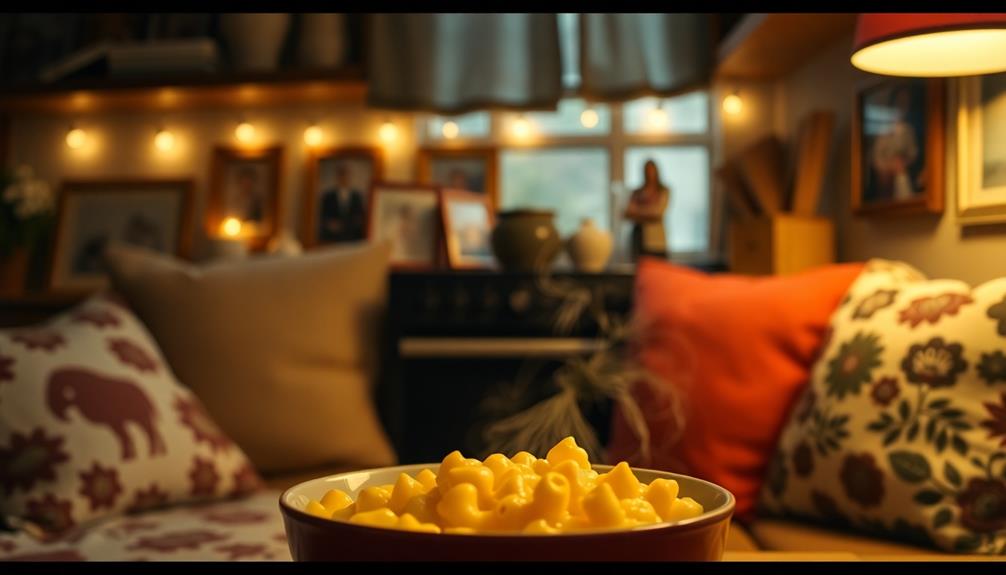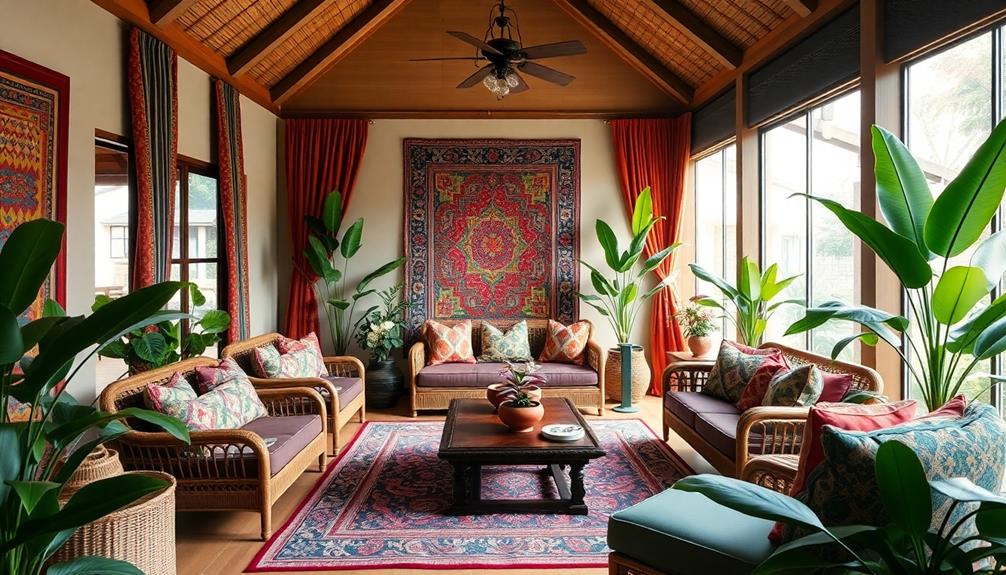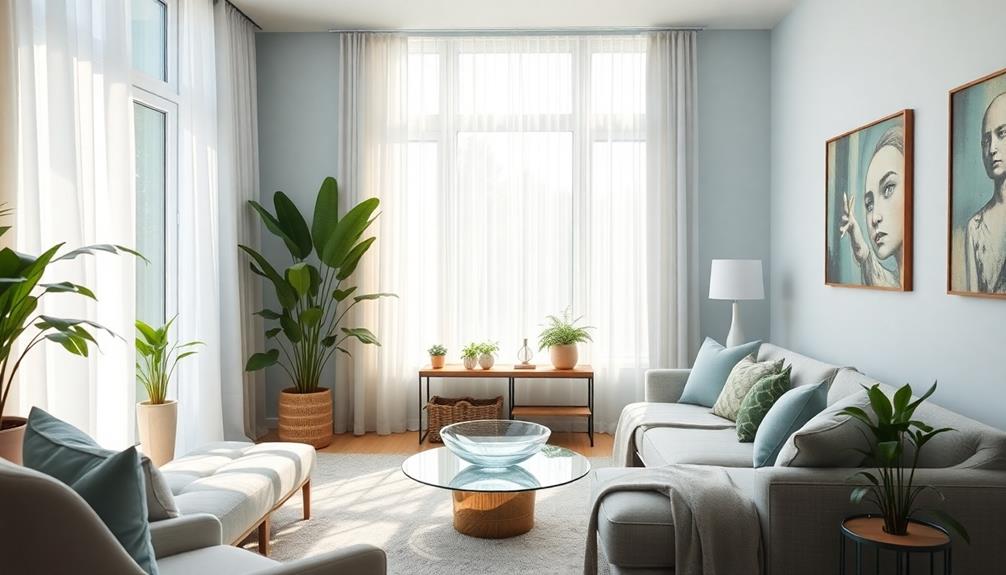Comfort food cravings are closely linked to your brain's response to stress and reward. When you're stressed, cortisol levels rise, heightening your desire for high-calorie comfort foods like pizza and ice cream. This craving is driven by the activation of brain reward pathways, making these indulgent foods more appealing. Emotional eating often follows, as these foods evoke nostalgia and provide comfort. However, this can lead to overeating and guilt. Understanding your emotional triggers can help you make healthier choices. There's much more to uncover about how stress influences your eating habits and cravings.
Key Takeaways
- Cravings for comfort foods are driven by stress-related hormones like cortisol, which increase appetite and enhance the appeal of high-calorie foods.
- The brain's reward pathways, particularly the mesolimbic dopamine system, are activated during stress, reinforcing cravings for indulgent, calorie-dense meals.
- Neurotransmitters such as neuropeptide Y (NPY) and enkephalins play a crucial role in modulating stress-induced cravings for comfort foods.
- Emotional eating can create a cycle of temporary relief followed by guilt, leading to long-term psychological distress and weight gain.
- Cultural influences and personal memories associated with traditional dishes contribute to the emotional connection and cravings for specific comfort foods.
Understanding Comfort Food Cravings
Understanding comfort food cravings involves recognizing how our emotions and stress levels can influence what we want to eat. When you're feeling overwhelmed or emotionally distressed, your brain activates its reward system, prompting cravings for high-calorie foods like ice cream, pizza, or chocolate. This reaction is largely driven by cortisol, the stress hormone, which increases your appetite and heightens your desire for these indulgent treats.
For many cultures, comfort foods such as Yeduba Wat or Zaru Soba serve as a nostalgic reminder of home and family, further intensifying these cravings.
As you indulge in comfort foods, you may notice that your brain temporarily deactivates satiety signaling, making you less aware of your fullness. This can lead to emotional eating, where you consume more than you actually need, chasing that fleeting feeling of satisfaction.
The appeal of comfort food lies in its ability to stimulate dopamine release, further enhancing its allure during stressful times.
In these moments, the nostalgia and emotional satisfaction tied to comfort foods can provide psychological relief, reinforcing the cycle of cravings. Understanding this connection helps you identify when your stress might be driving your food choices, allowing you to make more mindful decisions about what you eat.
The Role of Stress Hormones
Stress hormones play a considerable role in shaping your food cravings, particularly when emotions run high. When you experience stress, your body releases cortisol, which can greatly increase your appetite and trigger cravings for high-calorie comfort foods. This response is an evolutionary mechanism; however, it can lead to unhealthy eating patterns.
For instance, many people might find themselves reaching for rich and flavorful dishes like Mushroom Masala, as the blend of spices offers a comforting experience. Elevated cortisol levels enhance your brain's reward pathways, making high-fat and sugary foods more appealing. As a result, you may find yourself reaching for these calorie-dense options as a coping mechanism.
The activation of stress hormones disrupts your normal appetite regulation, pushing you towards emotional eating. Chronic exposure to stress causes hormonal changes that can lead to long-term alterations in brain function, making you more susceptible to cravings for comfort foods.
Research shows that the interplay between cortisol and appetite-regulating hormones fosters these unhealthy eating behaviors, ultimately promoting weight gain and associated health issues.
Recognizing how stress hormones influence your cravings can empower you to seek healthier coping strategies, potentially mitigating the urge to indulge in comfort foods during stressful times. Understanding this connection is key to maintaining a balanced approach to your emotional well-being and diet.
Neurobiological Mechanisms of Eating
When stress hits, your brain's reward pathways light up, making you crave those high-fat and sugary comfort foods.
This craving can be intensified by flavors and textures that evoke memories of comforting meals, such as traditional Brazilian desserts that are rich in sugar and fat.
Hormonal changes ramp up your appetite and push you toward calorie-dense options.
Understanding these neurobiological mechanisms can help you recognize why you reach for that extra slice of cake during tough times.
Brain Reward Pathways
Many people experience intense cravings for comfort foods, and this phenomenon is closely linked to the brain's reward pathways, particularly the mesolimbic dopamine system. When you indulge in high-fat and sugary foods, your brain releases dopamine, reinforcing the desire for these calorie-dense options. Dishes like Chilaquiles or Quesadillas can evoke similar feelings of comfort, as they're often associated with warm, nostalgic memories.
Stress amplifies this effect; cortisol released during stressful times increases neuronal reactivity in these reward pathways, leading to even stronger cravings for comfort food.
The lateral habenula also plays a significant role in how you respond to stress, as it can inhibit reward signals and influence your food intake behaviors during challenging moments.
Research indicates that chronic stress can downregulate satiety signaling in your brain, which may lead you to consume more palatable foods, even when you don't need the extra energy.
Moreover, neurotransmitters like enkephalins, produced by Proenkephalin neurons, modulate these reward-related responses, playing an essential role in stress-induced overeating behaviors.
Understanding how these brain reward pathways function can help you navigate those cravings and make healthier choices in times of stress.
Hormonal Influences on Appetite
Hormones play an essential role in regulating your appetite, particularly during times of stress. When you experience psychological stress, stress hormones like cortisol flood your system, increasing your appetite and cravings for high-calorie foods, such as Southern comfort food.
This hormonal response alters the normal appetite regulation mechanisms in your brain, making you more susceptible to emotional overeating. Elevated levels of corticosterone enhance neuronal reactivity to high-fat diets, pushing you towards overeating behaviors.
The activation of Proenkephalin neurons in the lateral hypothalamus is vital here, as their stimulation leads to an increased desire for high-fat foods. Additionally, neurotransmitters such as neuropeptide Y (NPY) are produced during stress, influencing your brain's reward pathways and contributing to weight gain through amplified cravings for palatable foods.
Interestingly, silencing these Proenkephalin neurons can normalize eating behavior in stressed individuals, suggesting a potential pathway for intervention. By targeting these neurobiological mechanisms, you could mitigate stress-induced overeating and regain control over your appetite.
Understanding the hormonal influences on your cravings can empower you to make healthier choices, even in challenging times.
Emotional Eating Patterns
When stress hits, you might find yourself reaching for those comforting, high-calorie foods that seem to soothe your emotions.
Foods like Nettle and Potato Soup or Slow-Cooked Pork Belly can evoke feelings of warmth and nostalgia, often tied to personal or cultural traditions.
These cravings aren't just random; they're tied to psychological mechanisms that connect food with comfort and cultural experiences.
Understanding these emotional eating patterns can help you recognize the cycle and make healthier choices.
Stress-Induced Cravings
Stress often triggers strong cravings for comfort foods, leading you to seek out high-calorie options as a means of coping with emotional challenges. When you're stressed, your body releases cortisol, which ramps up your appetite and drives you toward sugary and fatty foods. These choices stimulate the brain's reward centers, causing a release of dopamine that reinforces your desire for these comfort foods.
Research shows that elevated neuropeptide Y (NPY) levels during stress further contribute to your cravings. This chemical is linked to increased consumption of high-calorie foods, and blocking it has been found to reduce food intake in stressed individuals.
Here's a quick overview of how stress affects your cravings:
| Factor | Effect |
|---|---|
| Cortisol | Increases appetite |
| Neuropeptide Y (NPY) | Heightens comfort food cravings |
| Dopamine | Reinforces desire for high-calorie foods |
| Stress | Alters reward processing |
| Emotional Eating | Leads to obesity and psychological distress |
Understanding these connections can help you manage your cravings more effectively and find healthier coping mechanisms during stressful times.
Psychological Comfort Mechanisms
In the face of emotional turmoil, many people turn to comfort foods as a way to soothe their minds. Traditional Ethiopian dishes, such as Yeselata (Ethiopian Salad), are often rich in fresh ingredients that can provide nutritional benefits while still offering comfort.
During stressful times, cravings for high-calorie foods can surge, driven by the brain's reward centers activating and releasing dopamine. This feel-good neurotransmitter reinforces your desire for those indulgent treats.
However, when you eat comfort food, hormonal changes related to stress can deactivate your brain's satiety signals, leaving you feeling hungrier and more inclined to engage in emotional eating.
Cortisol, the stress hormone, plays a significant role in these cravings, often leading you to sugary and fatty foods. While this behavior may provide immediate relief from anxiety, it can also result in feelings of guilt as you become aware of potential weight gain and long-term health consequences.
This creates a self-perpetuating cycle, where emotional eating offers a psychological buffer against stress, but ultimately increases it.
Recognizing these patterns can empower you to seek healthier coping mechanisms. By understanding the interplay between your emotional state and food choices, you can take steps to break free from the cycle of unhealthy eating behaviors.
Cultural Food Connections
Emotional eating isn't just a personal response; it's deeply intertwined with cultural backgrounds that shape your comfort food preferences. Traditional dishes like Kue Putu and Dadar Gulung often evoke nostalgia and remind you of family gatherings or celebrations.
Your comfort food choices often reflect these meals that serve as emotional anchors, providing psychological relief during stressful times. When you indulge in foods that are part of your culinary heritage, you tap into a rich history that lifts your mood and offers a sense of security.
Whether it's a holiday feast or a simple family recipe, these dishes resonate emotionally, helping you cope with life's challenges. Different cultures bring varied flavors and practices to the table, showing how comfort foods can vary widely based on cultural background.
For some, it might be a hearty stew on a cold day, while for others, it's a sweet dessert reminiscent of childhood. The psychological benefits are clear: indulging in these comfort foods not only elevates your mood but also fosters a sense of belonging.
Long-term Impacts of Stress
Chronic exposure to stress can profoundly affect your eating habits and overall health. When you're under sustained stress, your body produces higher levels of cortisol, which can disrupt appetite regulation and drive cravings for high-calorie foods. This often reinforces unhealthy eating patterns, particularly comfort foods, as you seek emotional relief.
The brain's reward responses are also altered, especially in the lateral habenula, which plays a significant role in managing emotional responses related to eating behavior. This disruption can create a feedback loop, making it harder to break the cycle of stress and unhealthy eating. Over time, this maladaptive association can lead to weight gain and increased psychological distress.
Here's a quick overview of how chronic stress affects your eating:
| Aspect | Effect of Chronic Stress | Resulting Issues |
|---|---|---|
| Appetite Regulation | Increased cravings for high-calorie foods | Weight gain |
| Emotional Responses | Reliance on comfort foods for relief | Psychological distress |
| Reward Responses | Altered brain function (lateral habenula) | Risk of obesity-related health issues |
Understanding these impacts is essential for addressing long-term health challenges.
Strategies for Healthier Eating
Recognizing stress-induced cravings can be a game changer in your journey toward healthier eating. By differentiating between emotional and physical hunger, you can develop healthier coping strategies to manage your eating habits. For instance, turning leftover turkey into a delicious turkey sandwich can provide a satisfying meal that helps curb cravings while still being nutritious; consider trying Turkey Sandwich (For Leftovers).
Start incorporating regular physical activity into your routine; it can greatly reduce stress and improve your mood, making you less reliant on high-calorie comfort foods for emotional relief.
Meal preparation is essential. Create grocery lists to guarantee you have nutritious options on hand, and prep healthy snacks in advance. This not only streamlines your healthy eating efforts but also prevents impulse eating during stressful moments.
Focus on maintaining a balanced diet rich in fruits, vegetables, and whole grains; this can boost your mental health and curb cravings.
If you find emotional eating persists, don't hesitate to seek professional support. Nutritionists and therapists can offer tailored strategies to help you address these challenges and establish healthier eating patterns.
Future Research Directions
Understanding the intricate relationship between stress and comfort food cravings presents a promising avenue for future research. By delving into this connection, you can reveal valuable insights that may improve emotional regulation and eating behaviors.
For instance, exploring how cultural preferences for comfort foods, such as the rich flavors of Red-Braised Pork Belly, can influence these cravings could provide a deeper understanding of emotional eating.
Here are three key areas to explore:
- Neurobiological mechanisms: Investigate how Proenkephalin influences appetite during stress-induced eating episodes. Understanding these pathways could lead to targeted interventions.
- Pharmacological interventions: Look into glucocorticoid receptors in the hypothalamus. Targeting these receptors might help mitigate stress-related comfort food cravings.
- Genetic factors: Assess how individual differences in stress responses impact comfort food cravings. This could enhance personalized dietary recommendations for effective management.
Additionally, long-term studies are essential for understanding chronic stress's effects on eating patterns and potential behavioral adaptations.
Collaboration among neuroscientists, psychologists, and nutritionists is vital to develop holistic approaches for addressing comfort food cravings and emotional eating.
Frequently Asked Questions
What Is the Neuroscience of Comfort Eating?
When you experience stress, your brain's reward system kicks in, making you crave high-fat, sugary foods. This craving's fueled by hormones like cortisol and neuropeptide Y, which mess with your appetite and satiety signals.
What Does It Mean When You Crave Comfort Food?
When you crave comfort food, it feels like your soul's screaming for warmth. It's your body's way of seeking solace, joy, or relief during stressful times, turning to familiar flavors that soothe your spirit.
What Is the Neuroscience of Food Cravings?
Food cravings arise from your brain's reward system, where dopamine release reinforces desires for tasty, high-calorie foods. Stress triggers this response, increasing cortisol levels and amplifying cravings, which can lead to emotional eating patterns.
What Is the Psychology Behind Comfort Eating?
You're practically a superhero, battling stress with your trusty comfort foods! When life's chaos strikes, you reach for those nostalgic bites, seeking solace and joy, even if it leaves you feeling a tad guilty afterward.
Conclusion
To sum up, understanding the neuroscience behind comfort food cravings can help you make healthier choices. Did you know that nearly 75% of people turn to food for comfort during stressful times? By recognizing the role of stress hormones and emotional triggers, you can take control of your eating patterns. Implementing healthier strategies not only boosts your mood but also supports your overall well-being. Embrace these insights, and you'll find a more balanced approach to your cravings.









